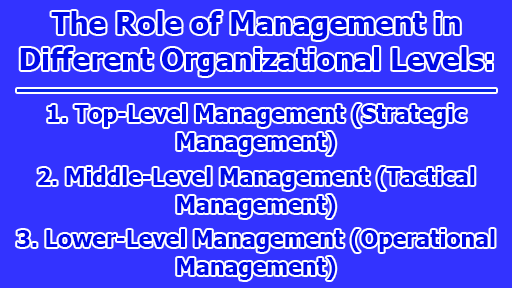The Role of Management in Different Organizational Levels:
Management is the driving force behind organizational success, guiding companies through various challenges and opportunities. Within an organization, management functions at different hierarchical levels, each level with distinct roles, responsibilities, and focuses. In the rest of this article, we will delve into the role of management in different organizational levels, exploring the tasks, skills, and strategic perspectives required to navigate today’s intricate business environments effectively.
1. Top-Level Management (Strategic Management):
Top-level management, often referred to as strategic management, operates at the highest echelons of the organizational hierarchy. This level includes executives such as CEOs, presidents, and chief officers. The role of top-level management is marked by its strategic vision, setting the tone for the entire organization’s direction. Key responsibilities include:
a) Strategic Planning: Top-level managers are responsible for charting the organization’s long-term goals, defining its mission, and formulating strategies to achieve sustainable growth. They analyze industry trends, evaluate competitive landscapes, and identify opportunities for expansion and innovation.
b) Decision-Making: Strategic decisions with significant implications for the organization’s future are made at this level. These decisions include major investments, mergers and acquisitions, and entry into new markets.
c) Resource Allocation: Top-level managers allocate resources such as budget, manpower, and technology to initiatives that align with strategic objectives. They prioritize projects that contribute to the organization’s long-term vision.
d) Stakeholder Engagement: Building and maintaining relationships with stakeholders such as shareholders, investors, and regulatory bodies is essential for maintaining the organization’s reputation and ensuring compliance with legal and ethical standards.
e) Leadership and Culture: Top-level managers set the organizational culture, values, and ethical standards. Their leadership style shapes employee behavior, attitudes, and the overall work environment.
2. Middle-Level Management (Tactical Management):
Middle-level management, known as tactical management, operates between top-level and lower-level management. This level includes department heads, branch managers, and regional managers. Middle-level managers play a crucial role in translating strategic decisions into practical plans and ensuring efficient execution. Key responsibilities include:
a) Operational Planning: Middle-level managers break down strategic goals into specific objectives for their respective departments or functional areas. They develop detailed plans, allocate resources, and establish timelines to achieve these objectives.
b) Coordination: Middle managers coordinate activities within their departments to ensure alignment with overarching goals. They bridge the gap between top-level strategies and operational implementation.
c) Resource Management: These managers oversee the allocation of resources within their departments, including budgets, personnel, and equipment. They balance available resources with project demands.
d) Problem-Solving: Middle-level managers address challenges and issues that arise during daily operations. They find solutions to operational problems and implement changes to improve efficiency.
e) Performance Evaluation: Middle managers assess their teams’ performance, providing feedback, identifying areas for improvement, and recognizing achievements. They play a crucial role in employee development.
3. Lower-Level Management (Operational Management):
Lower-level management, also known as operational management, consists of supervisors, team leaders, and front-line managers. This level is responsible for executing day-to-day tasks that contribute to achieving organizational objectives. Key responsibilities include:
a) Task Execution: Operational managers oversee the execution of tasks, processes, and procedures within their teams. They ensure that work is completed efficiently, effectively, and in line with quality standards.
b) Employee Supervision: Operational managers provide direct supervision to employees. They assign tasks, monitor progress, and address performance issues as they arise.
c) Training and Development: These managers play a role in training new employees, imparting skills, and facilitating ongoing learning. They help team members enhance their abilities and adapt to changing requirements.
d) Resource Utilization: Operational managers ensure that resources, such as manpower and materials, are used optimally to achieve targets within specified timeframes.
e) Communication: Effective communication between top-level decisions and front-line execution is vital. Operational managers relay information, goals, and expectations to their teams, ensuring alignment and clarity.
f) Problem Resolution: Operational managers handle day-to-day challenges, troubleshoot issues, and make real-time decisions to maintain smooth operations.
It is apparent that management operates at different levels within organizations, each level contributing distinct value to the overall success of the company. Top-level management focuses on long-term strategies and vision, middle-level management translates strategies into actionable plans, and lower-level management ensures the execution of day-to-day operations. These management levels collaborate to achieve organizational objectives, align efforts, and optimize resource utilization. A well-coordinated management structure enhances organizational effectiveness, adaptability, and resilience in the face of dynamic business environments. By recognizing and embracing the diverse roles of management across levels, organizations can thrive and flourish in today’s complex and competitive landscape.

Library Lecturer at Nurul Amin Degree College










